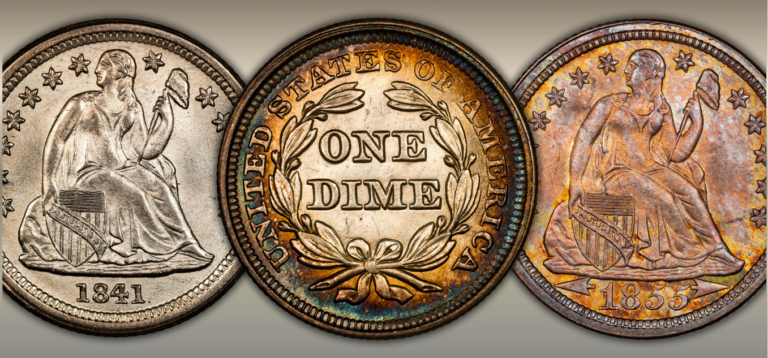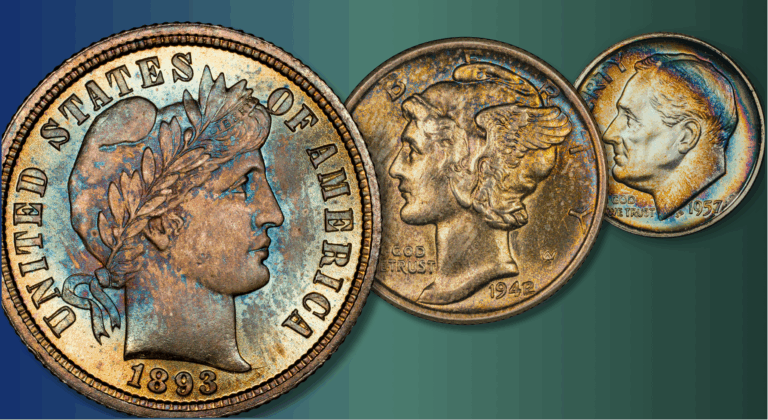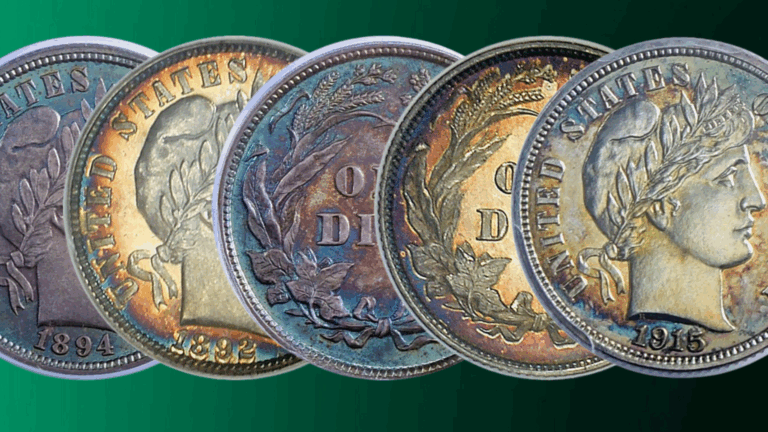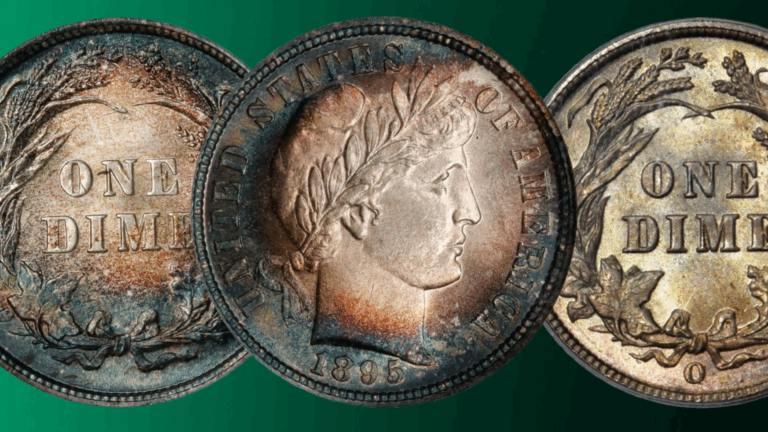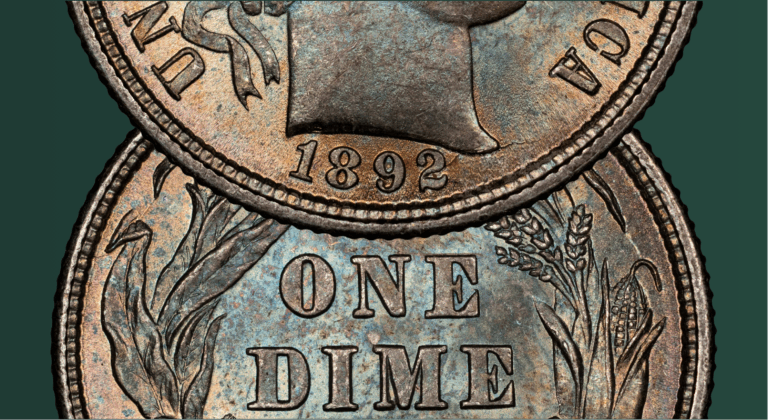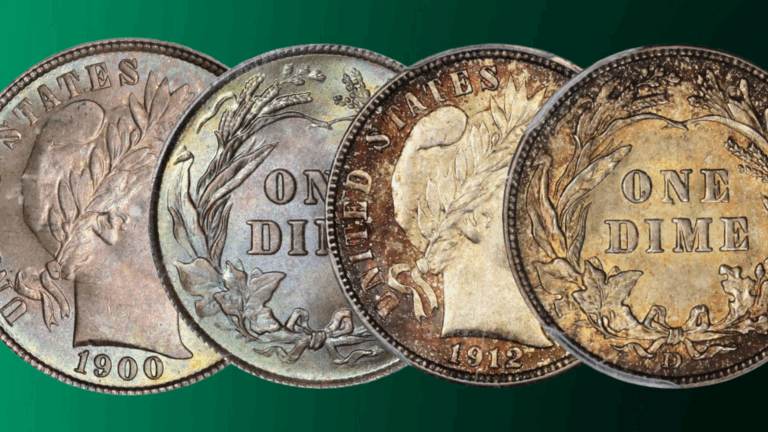by Greg Reynolds
This is an installment in my series on assembling a set ‘by date’ of Liberty Seated half dollars in Very Fine to Almost Uncirculated grades (VF-20 to AU-55), which is a practical objective. In this part, Liberty Seated halves minted from 1853 to 1860 are covered, a period after the initial shock of the California Gold Rush and before the era of the U.S. Civil War (1861-65) during which attitudes towards coins changed.
Naturally toned VF to XF grade Liberty Seated halves are often much more pleasing than MS-60 to -63 grade pieces that have lots of hairlines, annoying contact marks, discolorations from cleaning, or are unnaturally bright white. Certified MS-60 to -63 Liberty Seated half dollars are far more likely to have been subject to deliberate modifications than VF-20 to AU-55 grade Liberty Seated half dollars, most of which toned naturally in albums or envelopes, years before they were certified.
The half dollars minted from 1853 to 1860 are of three design types: 7) Liberty Seated, With Drapery, No Motto (1839-53, 1856-66); 8) Liberty Seated, Arrows & Rays (1853 only); 9) Liberty Seated, No Motto, With Arrows, No Rays (1854-55). A whole list of all design types of U.S. silver half dollars is put forth in multiple other guides on this site.
Type #8 — Liberty Seated, Arrows & Rays (1853 only)
The half dollars of 1853 are highly demanded as a one-year type. Furthermore, the combination of arrows on the obverse (front) and rays on the reverse (back) is entertaining. When I was a kid, I very much desired an 1853 half. I was thrilled the first time that I saw one.
As explained in my guide to collecting half dollars by design type on this website, arrows and rays were added to signify a reduction in the silver content of quarters and half dollars. As there was not much room for rays on dimes and half dimes, just arrows were added to those.
During the late 1840s and early 1850s, discoveries of massive quantities of gold in California resulted in a large increase in the supply of gold in the United States. The value of silver, figured in gold, increased because there was much additional gold and not much of an increase in the amount of silver available. Although a law passed in 1834 fixed the monetary ratio of silver to gold, this ratio fluctuated in reality with market conditions. By 1851, it was clearly advantageous to melt, trade or export U.S. silver coins as their value in silver as a metal became greater than their respective face values. For example, the silver in ten half dollars altogether was worth more than one half eagle ($5 gold coin).
Consequently, a new law reduced the silver content in all silver coins except silver dollars. It was important for U.S. citizens to become aware of this law and to be continually reminded about it so that they would spend new silver coins to benefit the nation’s economy rather than hoard them or sell them as bullion. Essentially, arrows indicated a reduction in silver content.
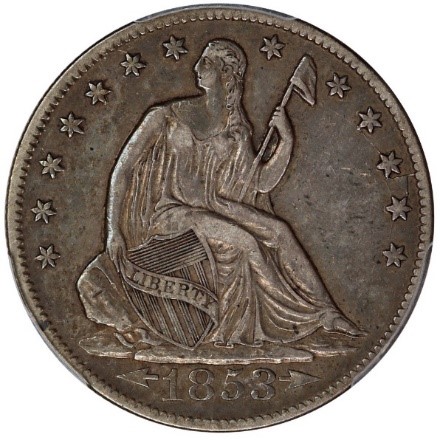
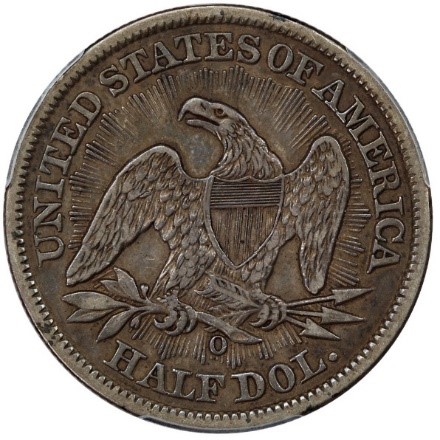
Dies with arrows and rays were prepared in Philadelphia and shipped to New Orleans. Half dollars were not minted in San Francisco in 1853. The U.S. Branch Mint in San Francisco did not start producing coins until 1854, and half dollars were not struck there until 1855.
Philadelphia Mint 1853 halves are not especially expensive. On Aug. 14, 2022, the firm of David Lawrence sold a CAC approved, NGC graded XF-40 1853 half for $385. In February 2022, the firm of Gerry Fortin sold a CAC approved, PCGS graded XF-45 1853 for $475. On Dec. 19, 2021, GreatCollections sold a CAC approved, NGC graded AU-53 1853 half for $705.58.
It may be difficult to find a CAC approved 1853 half that grades below XF-40, as dealers do not often submit those to CAC. In November 2022, a fair retail price for a CAC approved VF-25 grade 1853 would be around $200.
The 1853 New Orleans Mint issue is scarcer than the Philadelphia Mint 1853 half. Moreover, 1853-O halves are not often offered publicly. Quite a few dealers have customers for them.
In August 2022, Gerry Fortin sold a CAC approved AU-53 grade 1853-O half for $1850. On Oct. 2, 2022, Great Collections sold a CAC approved, PCGS graded XF-40 1853-O half for $677.25. A CAC approved VF-20 or VF-25 grade 1853-O would be likely to be a good value if one could be found. Unfortunately, as of Sept. 25, 2022, CAC has approved zero as Fine-15, zero as VF-20, zero as VF-25, one as VF-30 and six as VF-35.
Hopefully, it is apparent that 1853-O Arrows & Rays halves are being discussed here. There exist 1853-O halves without rays or arrows, though just three of those have been certified. Each 1853-O ‘No Arrows, No Rays’ half is worth a six-figure amount. Most collectors of Liberty Seated half dollars by date just ignore the 1853-O No Arrows coins.

Type #9 — Liberty Seated, No Motto, With Arrows, No Rays (1854-55)
For decades, R. W. Julian has been the leading researcher of U.S. Mint records from the 19th century. Julian informed me that he has never found a formal explanation in official documents for the removal of rays from the design in 1854 and for the removal of arrows two years later. All 1854 and 1855 half dollars have arrows, but not rays.
Surprisingly, by 1856, half dollars had neither arrows nor rays in their design and appeared like pre-1853 Liberty Seated half dollars even though those each contained more silver, on average, than post-1853 half dollars. The weight standards for silver coins that were itemized in the Coinage Act of 1853 remained in effect until the Coinage Act of 1873 was implemented.
The presence of rays may have caused the reverse design to be too tightly packed with design elements. Moreover, the rays may possibly have led to suboptimal metal flow during the striking of 1853 half dollars and to excess die wear. It would have made sense, however, for arrows to remain on the obverse to discourage people from hoarding silver coins minted from 1856 onward.
The appearance of arrows on halves may have spurred hundreds of people to save them as a substantial number of Philadelphia Mint 1853, 1854 and 1855 ‘With Arrows’ half dollars survive. Indeed, these are not rare.
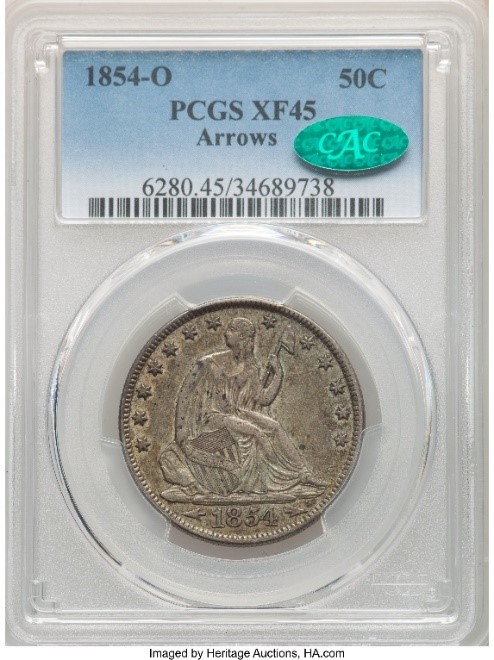
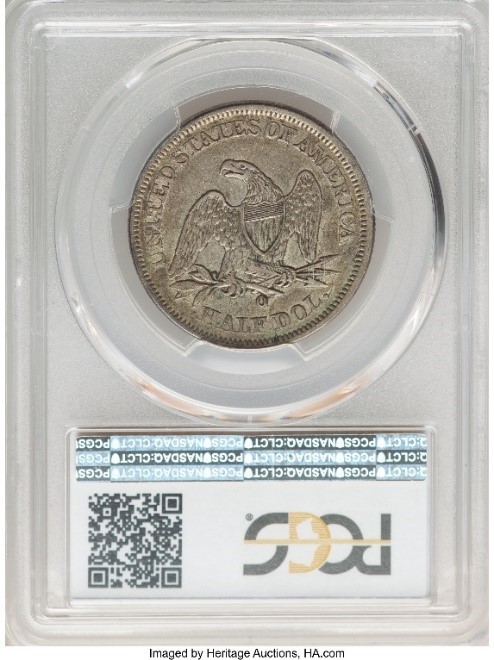
1854 Liberty Seated Half Dollars
In theory, a CAC approved Very Fine grade 1854 would be likely to retail for less than $160. It might be even more difficult, however, to find a CAC approved Very Fine grade 1854 than to find a CAC approved 1853-O. On March 13, 2022, GreatCollections sold the lone CAC approved VF-25 1854 ‘With Arrows’ half dollar for $124.65.
CAC has approved zero 1854 halves as Fine-12, zero as Fine-15, zero as VF-20, the just mentioned coin as VF-25, zero as VF-30, three as VF-35, three as XF-40, eight as XF-45 and seven as AU-50. The fact that dealers do not often submit these is not the only reason why CAC approved representatives of this type may be hard to find. Many were chemically cleaned in the past and failed at CAC. Others have suffered from corrosion or natural discoloration. On July 27, 2022, Stack’s Bowers sold a CAC approved AU-55 grade 1854 half for $456.
In circulated grades, the CPG-CAC retail price estimates for the 1854-O are the same as those for the 1854 Philadelphia Mint half. For coins grading from XF-40 to AU-58, the CAC population for the 1854-O is much greater than the corresponding population for the 1854. CAC approved VF-20 to AU-55 grade 1854-O halves, though, do not seem to show up more often than CAC approved 1854 halves in auctions or public Internet sales.
On Oct. 26, 2021, Heritage sold a CAC approved XF-45 grade 1854-O for $250.80. In January 2021, Gerry Fortin auctioned a CAC approved, PCGS graded AU-55 1854-O for $700.
1855 Liberty Seated Half Dollars
In theory, a CAC approved XF-40 grade 1855-O should retail for a price between $200 and $265, though finding one might not be easy. On July 31, 2022, GreatCollections sold a CAC approved, NGC graded XF-45 1855-O for $311.28. On April 26, 2022, Heritage sold a CAC approved, PCGS graded AU-53 1855-O half for $444.
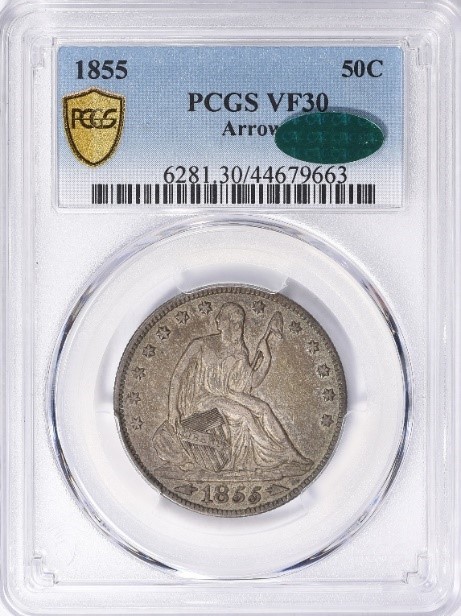
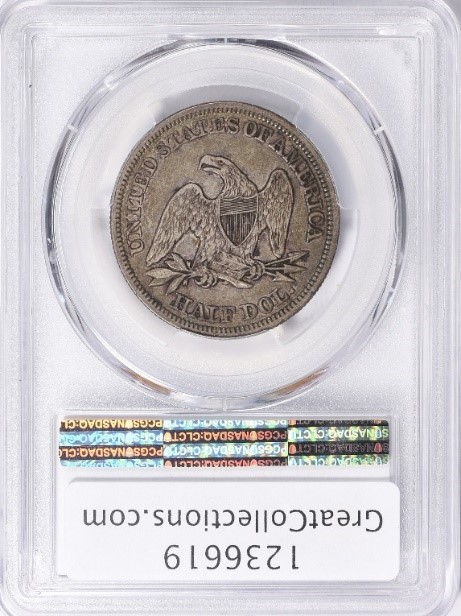
As for the so-called “1855/54” overdate half dollar, there are logical reasons to doubt its importance. An overdate may be granted the status of an additional date of a given year if the overdate features are clear and visible without magnification. On “1855/54” halves, a high degree of magnification and a scientific analysis are required to make a case that this variety really is an 1855/54 overdate.
This variety might very well be an 1855/54 overdate, but there is not readily apparent evidence, and the subject matter is complicated. This variety should be limited to collectors who are collecting by die pairing; it is not another date of the year 1855 and it should not be classified as a major variety either. It is a subtle variety.
Price guides suggest a premium of 100% or more for a so-called “1855/54.” In my opinion, only collectors who are building sets of Liberty Seated halves by die pairing should feel compelled to acquire a representative of this variety. It is logical for those collecting by date to ignore it.
The 1855-S is much scarcer than the other dates of the 1854-55 or 1853 ‘With Arrow’s types. It is a semi-key to the whole series of Liberty Seated half dollars.
David Queller liked to discuss the importance of the 1855-S and how difficult it was to find an 1855-S that he found to be acceptable. Queller devoted a great deal of time and energy to collecting half dollars. His extremely extensive set of half dollars was auctioned by Stack’s (NY) in 2002. He also owned 1804 and 1870-S silver dollars, among thousands of U.S. coins.
To me, Queller talked more about his 1855-S and 1838-O half dollars than about any other coins. He was much more enthusiastic about his prized half dollars than he was about his 1804 silver dollar, which I wrote about in multiple articles. If David was still alive, he would like to advise collectors of Liberty Seated halves to be very patient and wait for a likable 1855-S to become available for a fair price.
A collector may really have to wait for a very appealing 1855-S. As of Oct. 10, 2022, CAC has approved zero 1855-S halves in the Very Fine grade range, zero as XF-40, four as XF-45, one as AU-50, zero as AU-53, zero as AU-55 and three as AU-58. On Jan. 30, 2020, Legend auctioned a CAC approved AU-58 grade 1855-S for $14,100. A collector who is considering an inexpensive 1855-S, such as one that grades in the VG to Fine range, or a non-CAC 1855-S in the Very Fine grade range, should consult an expert before effecting a purchase.

Show off Your Collection in the CAC Registry!
Have CAC coins of your own? If so, check out the CAC Registry–the free online platform to track your coin inventory, showcase your coins by building public sets, and compete with like-minded collectors!
Type #7 –With Drapery, No Motto (1839-53, 1856-66)
In 1856, type #7 was resumed, though an important difference is that coins minted before the Coinage Act of 1853 was implemented contain more silver, on average, than half dollars of the same type that were minted later. In other words, the specified silver content (185.625 grains = 0.387 Troy ounce) of coins of this design type that were minted before 1853 is greater than the specified silver content of those minted from 1856 to 1866, 172.8 grains, which equals 0.36 Troy ounce.
As of October 2022, fair retail prices for relatively common dates after 1855 and before 1866 are $200 in XF-40 grade, $250 in XF-45 grade, $375 in AU-50, and $400 in AU-53. The following dates are relatively common: 1856, 1856-O, 1857, 1858, 1858-O, 1859, and 1859-O.
The 1856-S is a ‘better date,’ perhaps a semi-key. On July 4, 2021, Heritage sold a CAC approved XF-40 grade 1856-S for $1969.88, a very strong price. An AU grade 1856-S, though, currently has a medium retail value above $2000.
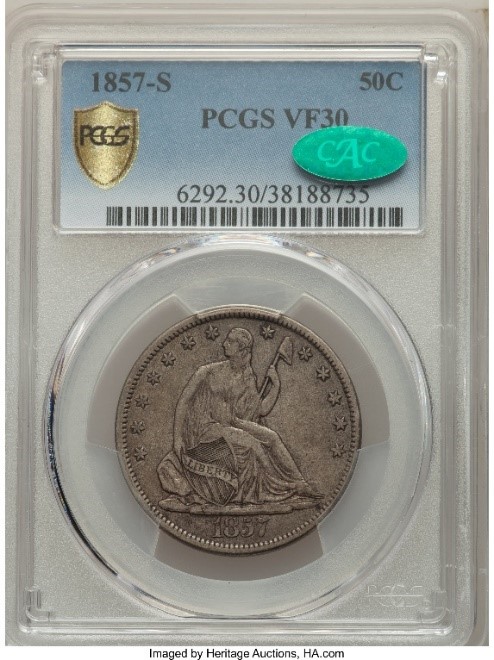
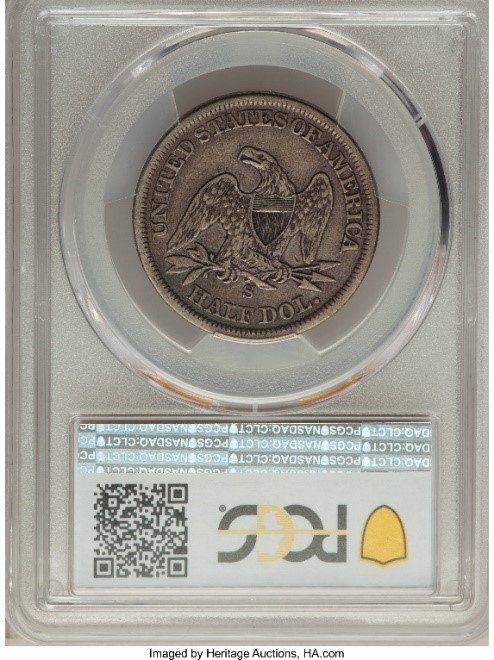
In the VF to AU grade range, the 1857-S is even scarcer than the 1856-S. On Dec. 7, 2019, a CAC approved VF-30 grade 1857-S was sold by Heritage for $1050. On June 14, 2020, GreatCollections sold a CAC approved XF-45 grade 1857-S for $2570.62
In comparison to the 1856-S and the 1857-S, the 1858-S has been thought to be relatively common, yet an extremely small number of circulated 1858-S halves have been approved by CAC: zero below VG-10, one as VG-10, one as Fine-12, zero as Fine-15, one as VF-20, zero as VF-25, three as VF-30, zero as VF-35, five as XF-40, one as XF-45, zero as AU-50, zero as AU-53, and one as AU-55. The total number of 1858-S half dollars approved by CAC in all grades is just seventeen.
In my view, leading price guides have notably underestimated the values of 1858-S halves. Price-conscious buyers may wish to consult an expert before acquiring an 1858-S. Besides, it could take a lot of time to find a CAC approved 1858-S half in the VF-20 to AU-55 grade range.
Although the 1859-S is not as scarce as the 1858-S, it does command a significant premium. On April 18, 2021, DLRC sold a CAC approved, PCGS graded XF-40 1859-S for $390.
In the context of CAC approved coins that are certified as grading from VF-20 to AU-55, the 1859-S and the 1860 are of very similar rarity. On Dec. 31, 2019, a CAC approved AU-53 grade 1860 was sold by Heritage for $432.
The 1860-O is not one of the least scarce dates in the series, and it is not a semi-key; its scarcity rating is in the middle. A collector need not be in a hurry to acquire one. The CPG-CAC medium retail estimate for an XF-40 grade 1860-O is $242. On April 5, 2022, Stack’s Bowers auctioned a CAC approved AU-55 grade 1860-O for $660.
The 1860-S is definitely a scarcer date. The PCGS population in all grades is under two hundred and twenty. The CAC population is just twenty, and months of waiting may be required to purchase a CAC approved 1860-S half for a fair collector price. On Oct. 27, 2019, DLRC sold a CAC approved XF-40 grade 1860-S for $300.
If someone who was unfamiliar with the subject of Liberty Seated half dollars glanced at price guides, he or she may become under the impression that all those from 1856 to 1860 are available in VF-20 grade for $100 to $700 each, usually very close to $100. In reality, these may be difficult to find in VF grades, and dealer asking prices may often be substantially higher than value estimates in price guides.
For circulated Liberty Seated halves, there are not many CAC approved coins. Coin collectors, however, tend to enjoy challenges. If completing a set was extremely easy, then it would not be fun to complete it. A set of CAC approved Liberty Seated halves from 1839 to 1865 is certainly practical and would not be very expensive in the context of 19th century U.S. silver coins. The ‘With Motto’ type is a different matter.
Images are copyrighted by GreatCollections.com, DLRC (DavidLawrence.com), and Heritage Auctions (ha.com).
Copyright © 2022 Greg Reynolds
About the Author
Greg is a professional numismatist and researcher, having written more than 775 articles published in ten different publications relating to coins, patterns, and medals. He has won awards for analyses, interpretation of rarity, historical research, and critiques. In 2002 and again in 2023, Reynolds was the sole winner of the Numismatic Literary Guild (NLG) award for “Best All-Around Portfolio”.
Greg has carefully examined thousands of truly rare and conditionally rare classic U.S. coins, including a majority of the most famous rarities. He is also an expert in British coins. He is available for private consultations.
Email: Insightful10@gmail.com
